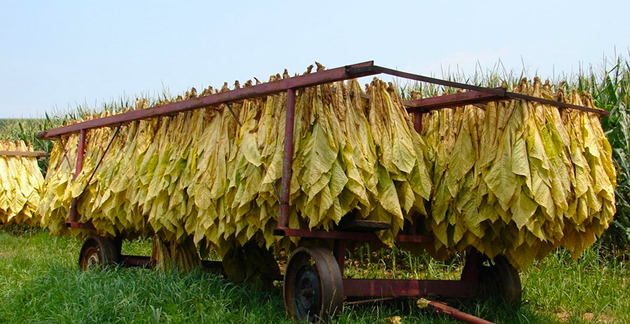Making the money, smoking the forests


Inasmuch as we all appreciate the importance of tobacco in economic development, we cannot perpetuate the depletion of forests when alternatives abound
George Chisoko Senior Assistant Editor
THE phenomenal growth that has been registered in the tobacco sector has, to a very large extent, shamed opponents of land reform, who never imagined the sector rebounding to the three-digit production levels. From a pathetic output of 50 million kg about 10 years ago to 75 million kg and to 100 million kg and rising to 165 million kg in 2013 and 216 million kg in 2014 and close to 200 million in 2015, indeed it has been a roller-coaster for the sector regarded as one the biggest contributor to the Gross Domestic Product, at one time contributing 16 percent.
Indications are that as more and more farmers register with the Tobacco Industry and Marketing Board to grow the crop in the coming seasons, production should further increase. As at the close of the marketing season this year, about $600 million had gone into the pockets of the farmers, incredibly transforming their lives.
A drive to some of the tobacco growing communal areas shows a dramatic change in the standard of living of the farmers, with cars parked at many households. Many have been able to send their children to good boarding and private schools as they make thousands of dollars from tobacco production.
While it has been encouraging to see rural farmers enjoying good life from their toil on the land growing tobacco, the depletion of forests has become a major cause for concern. It is of concern because deforestation and agriculture in general, contribute to greenhouse gases that cause climate change, which in turn causes drought and other severe weather conditions.
Essentially, it is in the best interest of the country and the farmers to seek alternative energy sources to protect the trees. The cutting down of trees for firewood for household use and to cure tobacco has a huge bearing on climate change as alluded above. The pressure on trees grows every season as more farmers move from other crops to the more lucrative tobacco. The number of new growers increases every season by more than 15 000, with 80 percent coming from the A1 and communal sectors.
Obviously an increase of the hectarage under tobacco causes an increase in the rate at which trees are cut down to cure tobacco and surely sustainable and alternative sources of energy have to be found and adopted without further delay. Tobacco Research Board (TRB) general manager, Dr Dahlia Garwe says as an immediate intervention, the use of coal should be encouraged in the communal areas where farmers do not have access to electricity.
The TRB is involved in a number of research work, which should produce alternative energy sources as possible solution to the cutting down of trees. Solar and biogas are under trial at TRB to see if they can be used as sources of energy to cure tobacco. So far, results have not been pleasing in that the heat generation in both instances has failed to reach the maximum 70 degrees Celsius that is required to fire the tobacco barns and more trials and modifications continue to be carried out as the board seeks to come up with alternative energy sources that help save the trees and perpetuate tobacco production.
The rocket barn, commonly used in Malawi, which the TRB has modified, has achieved 65 percent wood saving compared to the traditional barns. Another type of barn, the KCC1, which handles 45 000 leaves, an equivalent of 1,5 hectares of cropped area has scored during trials a 58 percent wood saving. These barns would do well in areas where there are still trees and where afforestation has taken place since they are designed to use less firewood than would normally be used in conventional barns.
Coal is in abundance at Hwange and there are several coal merchants across the country who can ensure its delivery close to the farmers.
However, rural farmers have been reluctant to switch to coal because of the cost to bring it to their doorsteps. It was always going to be problematic asking farmers to make a choice between trees they cut at no cost and coal they have to pay for.
Logically, they would choose firewood. But the trees are gone yet we want to continue growing tobacco. Even the farmers themselves are worried and some I spoke to recently when I visited Mt Darwin to attend the burial of a relative were asking if they could be helped to be resettled either as A1 or A2 farmers in commercial farming.
They see this as their escape route from the rural areas where trees have been depleted. So, serious and painful decisions have to be taken to compel all tobacco farmers to switch to coal and save the forests as other alternative sources of fuel are being pursued. We must not forget that there is positive relationship between depletion of forests and climate change and so it is in our interest as a nation to come up with measures that stop the further cutting down of the few remaining trees.
To that effect I want to advocate for legislation that compels rural farmers, without access to electricity, to use coal. The legislation is not designed to punish farmers but to ensure that, in light of the depleting forests, they can still continue to grow tobacco and eke out a decent living.
I recall a 1,5 percent levy was introduced last year to be paid by tobacco farmers towards the reforestation programme. We are yet to be furnished by the Ministry of Finance and Economic Development on how much was raised this season and how the money was disbursed.
TIMB chief executive, Dr Andrew Matibiri said reforestation would address the depletion of forests but lamented that the programme was a medium-term project that would take five to six years for the trees to mature.
The programme was designed for farmers to plant trees in their respective areas to replace those they would have cut but given the time the trees would take to maturity, alternative energy sources would have to be adopted and the use of coal becomes the best option in the circumstances.
Tobacco farmers have been in the business for some time now to the extent that we do not expect them to find it difficult to afford the cost of coal. They must begin to factor coal in their production budgets and make it an expense they cannot avoid.
At the end of the day, we all appreciate the importance of tobacco in economic development but at the same time we cannot perpetuate the depletion of forests when alternatives abound. Let us explore the alternatives and see which best suits communal farmers’ circumstances, in the process saving the trees but also continuing to make money from tobacco.








Comments